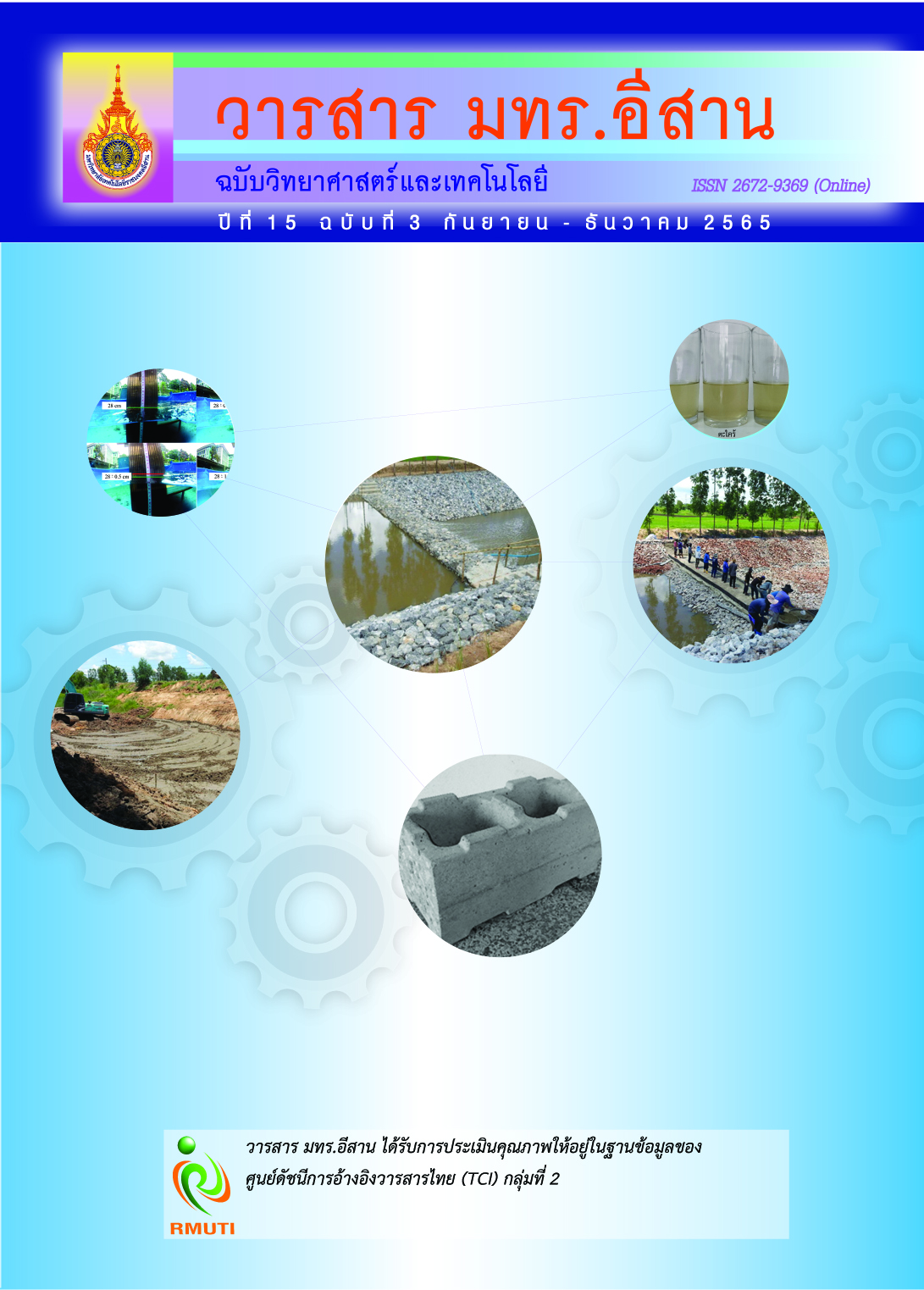พฤติกรรมด้านกำลังอัดของดินเหนียวผสมซีเมนต์ด้วยวิธีการบ่มที่แตกต่างกัน
Main Article Content
บทคัดย่อ
งานวิจัยนี้ศึกษากำลังอัดแกนเดียวของดินเหนียวผสมปูนซีเมนต์ที่บ่มแบบแช่น้ำและไม่แช่น้ำ โดยมีแนวความคิดการศึกษาจากการก่อสร้างฝายชะลอนํ้าโดยใช้ดินผสมซีเมนต์ (Core Zone Soil Cement Check Dam) การก่อสร้างฝายต้องทำอย่างรวดเร็วและตัวฝายต้องแช่นํ้าหลังจากก่อสร้างเสร็จทันที การศึกษาจะแปรผันตัวแปรควบคุม ได้แก่ ปริมาณปูนซีเมนต์ ปริมาณความชื้น สภาวะการบ่มแบบแช่น้ำและไม่แช่น้ำ และอายุบ่มการศึกษาโดยใช้ดินเหนียวผสมกับปูนซีเมนต์ที่อัตราส่วนร้อยละ 15 20 และ 25 ของนํ้าหนักดินแห้งปริมาณความชื้นที่ร้อยละ 80 100 และ 120 ของความชื้นที่เหมาะสม การทดสอบการบดอัดดินแบบสูงกว่ามาตรฐาน ผลการศึกษาพบว่า กำลังอัดแกนเดียวในทุกอัตราส่วนผสมมีค่าเพิ่มขึ้นตามอายุบ่มที่เพิ่มขึ้น ที่อัตราส่วนปริมาณน้ำในดินต่อซีเมนต์ตํ่าค่ากำลังอัดก็มีค่าสูงขึ้นเช่นกัน ผลการบ่มแบบแช่นํ้าและไม่แช่นํ้าพบว่าตัวอย่างดินซีเมนต์ที่ถูกบ่มในน้ำตลอดเวลาจะมีกำลังอัดต่ำกว่าตัวอย่างที่ไม่แช่น้ำตัวอย่างจะมีความเครียดที่จุดวิบัติและมีความเหนียว (Ductile) มากกว่าตัวอย่างแบบไม่แช่น้ำเล็กน้อย ผลของการแช่น้ำในช่วงเริ่มต้นเป็นการทำให้อัตราส่วนปริมาณน้ำในดินต่อซีเมนต์มีค่าเพิ่มขึ้น ส่งผลให้ตัวอย่างแบบแช่นํ้ามีกำลังอัดลดลง
Article Details

อนุญาตภายใต้เงื่อนไข Creative Commons Attribution-NonCommercial-NoDerivatives 4.0 International License.
เอกสารอ้างอิง
Katkan, W., Kumpala, A., and Horpibulsuk, S. (2008). An Approach for Assessement of Compaction Curves of Soils at Various Energies Using A One Point Test. RMUTI JOURNAL. Vol. 1, No. 2, pp. 15-31 (in Thai)
Na Nongkhai, P., Phojan, W., Pongnam, T., Chamchong, B., and Konyai, S. (2017). Core Zone Soil Cement Check Dam for Water Resource Management. International Conference on Engineering and Natural Science-Summer Session. Supporo Japan. August 23-25, 2017, pp. 88-99
Horpibulsuk, S., Rachan, R., Papattanotai, S., and Nagaraj, T. S. (2006). Analysis of Strength Development of Cement Stabilized Clay from Microstructural Consolidations. In Proceeding International Symposium on Lowland Technology. Saga, Japan, pp. 115-120
Jindapon, S., Yimsiri, S., Soralump, S., and Mitaim, S. (2006). Cement and Lime Stabilization of Soil in Submerged Condition. Kasetsart Engineering Journal. Vol. 20, No. 59, pp. 52-60 (in Thai)
Corp of Engineer. (1956). Summary Reviews of Soil Stabilization. In Proceeding, No. 13, Soil-Cement, Miscellaneous Paper, No. 3-122. Water Experiment Station, Vicksburg, p. 38
Portland Cement Association. (1969). Soil-Cement Construction Handbook. Construction Inspection Field Control. p. 11
Ingles, O. G. and Metcalf, J. B. (1972). Soil Stabilization Principles and Practice. Sydney. Butterworth PTY., p. 200
Clare, K. E. and Pollard, A. E. (1954). The Effect Of Curing Temperature On the Compressive Strenght Of Soil-Cement Mixtures. Geotechnique. Vol. 4, Issue 3, pp. 97-107. DOI: 10.1680/geot.1954.4.3.97
Horpibulsuk, S., Miura, N., and Nagaraj, T. S. (2003). Assessment of Strength Development in Cement - Admixed High Water Content Clay with Abrams Law as a Basic. Geotechnique. Vol. 53, Issue 4, pp. 439-444. DOI:10.1680/geot.2003.53.4.439


